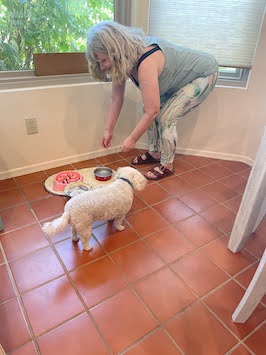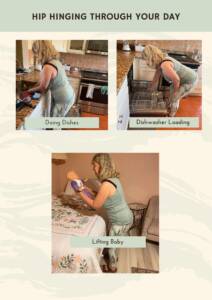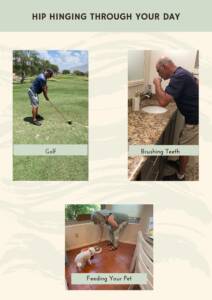What is hip hinging?
The hip hinge is an everyday functional movement and one applicable to yoga asana practice, exercise, and sports.
Why is it important?
In addition to all the benefits listed below, hip hinging will support: posture improvement, body awareness throughout your day, strength, and flexibility.
If any of the following apply to you, then please keep reading to learn how and why to hip hinge.
Own a cell phone
Pregnant or Postpartum
Do housework, cooking, and cleaning
Back Pain
Neck Pain
Poor Posture
Low-bone density
Osteoporosis
Arthritis
Tight hips
Sacroiliac joint pain
Exercise safety with or without weights or bands
Want to practice safe and enjoyable yoga for any of the above issues
Are you a parent, grandparent or caretaker of babies and toddlers?
You have so many opportunities to hip hinge to protect your back and spine! When you lift your child up from the floor, high chair or crib, when you change a diaper, when you are putting the child in their car seat, be mindful and hip hinge!
Do you have low bone density or osteoporosis in your spine?
If you move with hip hinge awareness throughout your day, you’re practicing spinal fracture prevention. Habitually rounding the back (flexion) or “shlump-asana” can stress the vertebrae and/or the muscles that support them, and could increase your risk of fracture. If you have low bone density or osteoporosis in your spine like I do, begin to hip hinge today!
Yet another important benefit:
We’re oriented forward throughout the day. Think eating, preparing food, working and playing on devices, driving. By mindfully and safely activating the important posterior muscles and tissues of our body including hips and entire spine, we wake them up, protect our backs, and employ our entire muscular skeletal system in everyday movements as well as exercise.
How do you hip hinge?
- Stand with feet hip joint distance apart
- Place your thumbs at the hip crease
- Hips go back first, then knees slightly bend
- Optionally, place a yard stick or dowel at the sacrum, upper back, and scull to maintain contact through the entire movement.
- Caveat: Make sure head doesn’t drop down and if lower back rounds it touches the dowel (check this out).
Note: There are three ways to hip hinge:
1-with flexed (bent) knees-addresses lengthening the tissues in the posterior body particularly in the glutes and lower back. This method is much more practical for most people and by far the variation I practice and teach most.
2-with straight knees-hamstring (back of leg) focus. Practical application applies in strength training exercises such as deadlifts.
3-every time you get up and down from a chair. See the video demonstration!
More ways to hip hinge:
What if I forget to hip hinge?
We aren’t striving for perfection! Habits take awhile to take hold in our mind/body. However, everytime you remember to hip hinge especially when lifting heavy objects, or preventing our heavy head (8-12 pound weight at the top of your spine!) to shlump forward, your body mechanics have improved. You have relieved stress on your backbone.
Our spine was built to move in seven directions: forward, back, lengthening, laterally (left and right), and rotationally to both sides. Our modern day postural habits, sedentary lifestyle, and more have favored spinal rounding. There are safe variations to move in ALL directions of our spine! (Work with me to learn more.)
Sources:
Prenatal and Postpartum Corrective Exercise Certification Course with Dr. Sarah Ellis Duvall
BoneFit® Professional, Trained through: Bone Health and Osteoporosis Foundation
Yoga for Holistic Healing: Poses and Sequences for Pain and Stress Relief by Bonnie J. Golden
Stay tuned for my next blog article demonstrating hip hinging in commonly taught yoga poses.
Check out my current teaching schedule, private sessions, and YouTube videos! All available remotely or in person.
Learn more about my teaching background, experience, and ways I can help you here.



